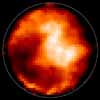| . |  |
. |
 Livermore - July 29, 1999 - The best images ever taken of Saturn's mysterious moon Titan reveal a complex surface that may be home to icy landforms and frigid hydrocarbon seas.
Livermore - July 29, 1999 - The best images ever taken of Saturn's mysterious moon Titan reveal a complex surface that may be home to icy landforms and frigid hydrocarbon seas.Astrophysicists from the Department of Energy's Lawrence Livermore National Laboratory and the University of California campuses at Los Angeles and Berkeley captured the images using a special technique on the world's largest telescope. According to Livermore astrophysicist Claire Max, these images from the Keck telescope are sharper than those from the Hubble Space Telescope, and show dark regions that may be seas of liquid hydrocarbons, as well as bright regions that may be ice-and-rock continents or highlands. The results appear this month in the planetary-science journal Icarus. The science team used a special observing technique known as "speckle interferometry" to obtain the high-resolution images of Titan, Saturn's largest moon. At 3,200 miles in diameter, Titan is larger than the planet Mercury and is the only body in the solar system with a nitrogen-rich atmosphere like the Earth's. Of course, located 900 million miles from the Sun, Titan is much colder than Earth, with a surface temperature of minus 180 degrees Celsius (-290 F). Observing Titan is extremely difficult. High in Titan's atmosphere, ultraviolet light changes methane gases into a thick smog-like organic haze that hides Titan's surface. When the Voyager spacecraft passed by in 1980, it saw only the orange-brown top of Titan's smoggy skies. Infrared light can penetrate the smog to see Titan's surface. Unfortunately, Titan is so far away that conventional telescopes see only a fuzzy blob because the image is blurred by Earth's atmosphere. Even the Hubble Space Telescope lacks sufficient resolution, especially in infrared light, to see much detail, though both Hubble and ground-based studies have shown that Titan has a complex surface. "With the tremendous power of the Keck Telescope we are able to map surface features 150 miles in size on a moon that is more than 800 million miles from Earth. I find this tremendously exciting to think about," Max said. The Livermore-UC group, including Livermore astrophysicsts Bruce Macintosh and Claire Max, planetary scientist Seran Gibbard, engineer Don Gavel, and UC Berkeley Professor Imke de Pater, studied Titan using the 10-meter Keck I telescope, the world's largest, on Mauna Kea, Hawaii. The blurring of the Earth's atmosphere was overcome using "speckle interferometry," a technique whereby hundreds of short snapshots, each fast enough to freeze the atmospheric turbulence, are computer-processed together. UCLA Professor Andrea Ghez was a pioneer in applying this technique to infra-red astronomy. Livermore scientists developed a version of speckle interferometry to image manmade satellites during the height of the Cold War; it was adapted to astronomical use by Laboratory engineer Don Gavel. "Speckle imaging is limited to bright, compact objects; Titan qualifies perfectly," Gavel said. Livermore's Gibbard worked with Chris McKay at NASA's Ames Research Center and Eliot Young of the Southwest Research Institute to convert these images into a map of surface features. The researchers removed light scattered in Titan's atmosphere to produce an image uncontaminated by haze. "These models give the first quantitative map of Titan's surface. The bright region shaped somewhat like a rubber duck seems to be made of a mixture of rock and ice," Gibbard said. A kidney-shaped region near the left edge of that image is made of an extremely dark material. Scientists have long suggested that ethane smog could condense and rain onto Titan's surface as a black liquid. "The dark material could be a sea of liquid methane, ethane, or other hydrocarbons," Macintosh said. "It's one of the darkest things in the solar system. It could also be solid organic material." Either possibility is exciting to scientists. If it is a sea, it represents the only such open body of liquid known beyond planet Earth. Whether the material is liquid or solid, the breakdown and re-assembly of complex organic molecules on Titan is similar to the complex chemistry that took place on Earth before life evolved. In some ways Titan is closer to the pre-biotic Earth than any other place in the solar system. Currently en route to Saturn, the Cassini spacecraft built by NASA and the European Space Agency is scheduled to land the Huygens probe on Titan in 2004. Ground-based studies such as the Keck observations will help predict whether the probe will land on a solid surface or splash into an extra-terrestrial sea.
|
| |||||||||
| The content herein, unless otherwise known to be public domain, are Copyright 1995-2016 - Space Media Network. All websites are published in Australia and are solely subject to Australian law and governed by Fair Use principals for news reporting and research purposes. AFP, UPI and IANS news wire stories are copyright Agence France-Presse, United Press International and Indo-Asia News Service. ESA news reports are copyright European Space Agency. All NASA sourced material is public domain. Additional copyrights may apply in whole or part to other bona fide parties. Advertising does not imply endorsement, agreement or approval of any opinions, statements or information provided by Space Media Network on any Web page published or hosted by Space Media Network. Privacy Statement All images and articles appearing on Space Media Network have been edited or digitally altered in some way. Any requests to remove copyright material will be acted upon in a timely and appropriate manner. Any attempt to extort money from Space Media Network will be ignored and reported to Australian Law Enforcement Agencies as a potential case of financial fraud involving the use of a telephonic carriage device or postal service. |